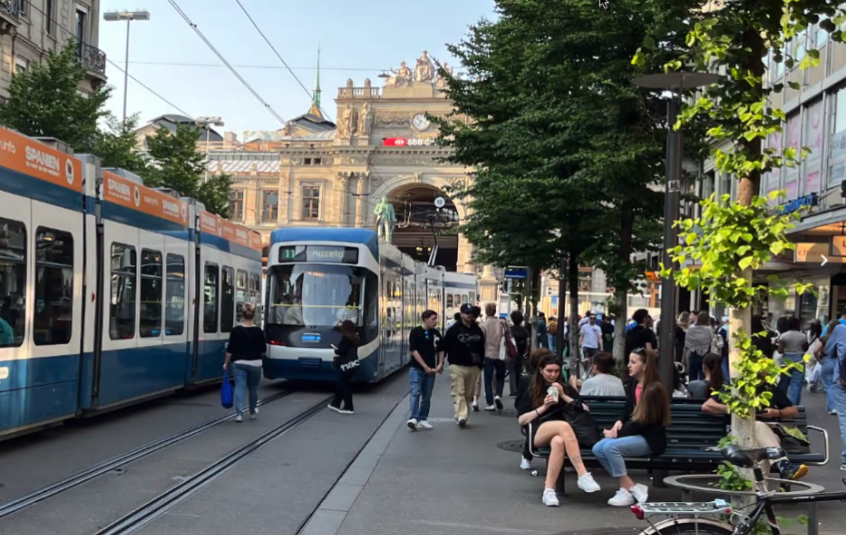In June, a delegation of advocates and other Bay Area transit leaders did an extensive study tour of public transit in Switzerland, which has one of the world's highest ridership systems. Their trains, buses, ferries, and trams are seamlessly integrated at the national, regional, and local levels. That's not to say they have one operator--actually, they have a couple of hundred. But they have a network manager, an overlay organization, that sets standards for fare and schedule integration and makes all trains, trams, buses, ferries, gondolas, etc. appear to customers as a single, giant, integrated transportation system.
"Switzerland is well known for an effective, high-ridership transit system," said Seamless Bay Area's Ian Griffiths, who was on the trip, at a panel discussion Thursday afternoon. He also pointed out that Switzerland is comparable in terms of size and population to the Bay Area. "It’s got a lot of local government, lots of jurisdictions," he said, "But transit ridership is four times our ridership, pre-pandemic."

The group experienced the Swiss system first-hand, taking transit all over the country, and never getting into a car after landing. They met with leaders at different levels of government. And they learned directly how the country created such an effective and integrated network even in a complex environment with many transit agencies.
"The biggest takeaway from the trip was seeing its success," said Seamus Murphy, Executive Director, SF Bay Ferry/WETA, who was also on the trip and who also participated in the panel. But the Swiss transportation system didn't happen overnight. "They were in a place decades ago that we are now," he said, "with declining ridership."
Swiss cities, such as Zurich, kept trying to pass ballot measures to fund transit, starting in the 1960s, explained Murphy. They failed repeatedly. But then by 1981 they sold a ballot funding measures that promised "regular-interval time tables, clock-face schedules, and they highlighted the S-bahn system and regional rail."
That resulted in a system that now is so expansive it serves urban and rural areas thoroughly. "Lausanne is about the size of Santa Rosa, but even it has an urban metro system," said Hannah Lindelof, Strategic Planning & Policy Group Manager at BART and another of the study tour participants. "There are resorts that don’t even allow cars and are only accessible by transit."

The idea, she explained, is to make transit more than a system for commuters. Instead, Swiss people can use transit for all trips. The panelists explained that the Swiss are willing to have poor fare-box recovery or even low ridership on rail lines well outside of major cities, as long as it supports an overall system that is consistent, fast, frequent, and available to all. "That comprehensive system results in a virtuous cycle, because people know they can rely on transit. That supports their willingness to continue to invest in transit and grow their network."
"The Swiss model doesn’t make transit an alternative or an equal to the car—it’s a superior choice," said Laura Tolkoff, Transportation Policy Director at SPUR and another panelist. She said in cities transit is at street level and given its own lane, with priority at signals. Expensive underground subways aren't generally necessary once one abandons the assumption that streets are primarily for cars. As a result, Swiss transit does a great job of supporting businesses. "People literally walk off the tram and straight into a store seamlessly," as seen in the lead image. The result: "The whole time we were there I don’t think saw a single vacant storefront."

How will all this apply to the Bay Area? The key, said the panelists, is making sure future ballot funding measures promise a transit system that won't be more of the same. Instead, people need the opportunity to vote on an integrated system with common fare media and coordinated schedules that's fast and frequent and comprehensive and never subservient to the automobile. The region has to show voters that they are funding an upgraded system that will work for everyone.
"Our goal is a regional vision for public transit," said Theresa Rommell, Funding Policy and Programs Section Director, MTC, who was also on the panel. "The plan is for an integrated and connected transit network, that is reliable, with improved speeds ... I see that as the opportunity."

With future funding measures, "if we ask the voters to just bail us out, we’re not going to be successful," said Murphy. "It’s time to subsidize our systems in a greater way, the way they do in Switzerland. We need to guarantee minimum standards when we ask voters to approve funding measures. And thanks to the work of Seamless Bay Area, we have a transformation action plan ... to decide those standards. We have to make sure those standards are applied if we want to do this right."
Want more? The full discussion was recorded and is available on YouTube.





